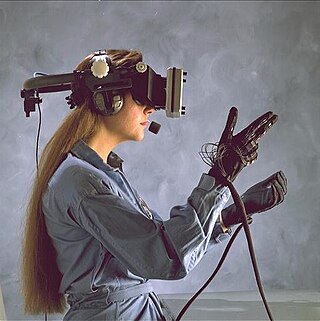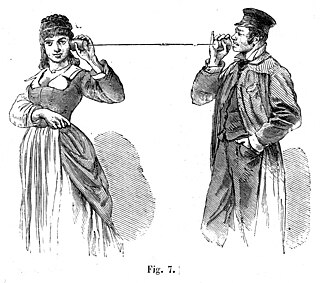
Amplitude modulation (AM) is a modulation technique used in electronic communication, most commonly for transmitting messages with a radio wave. In amplitude modulation, the amplitude of the wave is varied in proportion to that of the message signal, such as an audio signal. This technique contrasts with angle modulation, in which either the frequency of the carrier wave is varied, as in frequency modulation, or its phase, as in phase modulation.

Morse code is a method used in telecommunication to encode text characters as standardized sequences of two different signal durations, called dots and dashes, or dits and dahs. Morse code is named after Samuel Morse, one of the inventors of the telegraph.
In electronics and telecommunications, modulation is the process of varying one or more properties of a periodic waveform, called the carrier signal, with a separate signal called the modulation signal that typically contains information to be transmitted. For example, the modulation signal might be an audio signal representing sound from a microphone, a video signal representing moving images from a video camera, or a digital signal representing a sequence of binary digits, a bitstream from a computer.
The amplitude of a periodic variable is a measure of its change in a single period. The amplitude of a non-periodic signal is its magnitude compared with a reference value. There are various definitions of amplitude, which are all functions of the magnitude of the differences between the variable's extreme values. In older texts, the phase of a periodic function is sometimes called the amplitude.

Frequency-shift keying (FSK) is a frequency modulation scheme in which digital information is encoded on a carrier signal by periodically shifting the frequency of the carrier between several discrete frequencies. The technology is used for communication systems such as telemetry, weather balloon radiosondes, caller ID, garage door openers, and low frequency radio transmission in the VLF and ELF bands. The simplest FSK is binary FSK (BFSK), in which the carrier is shifted between two discrete frequencies to transmit binary information.
A transducer is a device that converts energy from one form to another. Usually a transducer converts a signal in one form of energy to a signal in another. Transducers are often employed at the boundaries of automation, measurement, and control systems, where electrical signals are converted to and from other physical quantities. The process of converting one form of energy to another is known as transduction.
A continuous wave or continuous waveform (CW) is an electromagnetic wave of constant amplitude and frequency, typically a sine wave, that for mathematical analysis is considered to be of infinite duration. It may refer to e.g. a laser or particle accelerator having a continuous output, as opposed to a pulsed output.

Haptic technology is technology that can create an experience of touch by applying forces, vibrations, or motions to the user. These technologies can be used to create virtual objects in a computer simulation, to control virtual objects, and to enhance remote control of machines and devices (telerobotics). Haptic devices may incorporate tactile sensors that measure forces exerted by the user on the interface. The word haptic, from the Greek: ἁπτικός (haptikos), means "tactile, pertaining to the sense of touch". Simple haptic devices are common in the form of game controllers, joysticks, and steering wheels.
Video modulation is a strategy of transmitting video signal in the field of radio modulation and television technology. This strategy enables the video signal to be transmitted more efficiently through long distances. In general, video modulation means that a higher frequency carrier wave is modified according to the original video signal. In this way, carrier wave contains the information in the video signal. Then, the carrier will "carry" the information in the form of radio frequency (RF) signal. When carrier reaches its destination, the video signal is extracted from the carrier by decoding. In other words, the video signal is first combined with a higher frequency carrier wave so that carrier wave contains the information in video signal. The combined signal is called radio-frequency signal. At the end of this transmitting system, the RF signals stream from a light sensor and hence, the receivers can obtain the initial data in the original video signal.
Stimulus modality, also called sensory modality, is one aspect of a stimulus or what is perceived after a stimulus. For example, the temperature modality is registered after heat or cold stimulate a receptor. Some sensory modalities include: light, sound, temperature, taste, pressure, and smell. The type and location of the sensory receptor activated by the stimulus plays the primary role in coding the sensation. All sensory modalities work together to heighten stimuli sensation when necessary.
Bone conduction is the conduction of sound to the inner ear primarily through the bones of the skull, allowing the hearer to perceive audio content even if the ear canal is blocked. Bone conduction transmission occurs constantly as sound waves vibrate bone, specifically the bones in the skull, although it is hard for the average individual to distinguish sound being conveyed through the bone as opposed to the sound being conveyed through the air via the ear canal. Intentional transmission of sound through bone can be used with individuals with normal hearing — as with bone-conduction headphones — or as a treatment option for certain types of hearing impairment. Bones are generally more effective at transmitting lower-frequency sounds compared to higher-frequency sounds.

A tin can phone is a type of acoustic (non-electrical) speech-transmitting device made up of two tin cans, paper cups or similarly shaped items attached to either end of a taut string or wire.

In telecommunications, visible light communication (VLC) is the use of visible light as a transmission medium. VLC is a subset of optical wireless communications technologies.

The invention of the telephone was the culmination of work done by more than one individual, and led to an array of lawsuits relating to the patent claims of several individuals and numerous companies.
The Optacon is an electromechanical device that enables blind people to read printed material that has not been transcribed into Braille. The device consists of two parts: a scanner which the user runs over the material to be read, and a finger pad which translates the words into vibrations felt on the finger tips. The Optacon was conceived by John Linvill, a professor of Electrical Engineering at Stanford University, and developed with researchers at Stanford Research Institute. Telesensory Systems manufactured the device from 1971 until it was discontinued in 1996. Although effective once mastered, it was expensive and took many hours of training to reach competency. In 2005, TSI suddenly shut down. Employees were "walked out" of the building and lost accrued vacation time, medical insurance, and all benefits. Customers could not buy new machines or get existing machines fixed. Some work was done by other companies but no device with the versatility of the Optacon had been developed as of 2007. Many blind people continue to use their Optacons to this day. The Optacon offers capabilities that no other device offers including the ability to see a printed page or computer screen as it truly appears including drawings, typefaces, and specialized text layouts.
In a digitally modulated signal or a line code, symbol rate, modulation rate or baud rate is the number of symbol changes, waveform changes, or signaling events across the transmission medium per unit of time. The symbol rate is measured in baud (Bd) or symbols per second. In the case of a line code, the symbol rate is the pulse rate in pulses per second. Each symbol can represent or convey one or several bits of data. The symbol rate is related to the gross bit rate, expressed in bits per second.
A vibrator is a mechanical device to generate vibrations. The vibration is often generated by an electric motor with an unbalanced mass on its driveshaft.
Whole body vibration is a generic term used when vibrations of any frequency are transferred to the human body. Humans are exposed to vibration through a contact surface that is in a mechanical vibrating state. Humans are generally exposed to many different forms of vibration in their daily lives. This could be through a driver's seat, a moving train platform, a power tool, a training platform, or any one of countless other devices. It is a potential form of occupational hazard, particularly after years of exposure.
Vocal resonance may be defined as "the process by which the basic product of phonation is enhanced in timbre and/or intensity by the air-filled cavities through which it passes on its way to the outside air." Throughout the vocal literature, various terms related to resonation are used, including: amplification, filtering, enrichment, enlargement, improvement, intensification, and prolongation. Acoustic authorities would question many of these terms from a strictly scientific perspective. However, the main point to be drawn from these terms by a singer or speaker is that the result of resonation is to make a better sound, or at least suitable to a certain esthetical and practical domain.
Assistive Technology for the Deaf and Hard of Hearing is technology built to assist those who are deaf or suffer from hearing loss. Examples of such technology include hearing aids, video relay services, tactile devices, alerting devices and technology for supporting communication.






